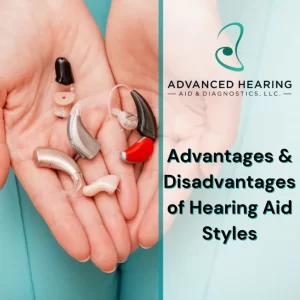
There are several different styles or sizes of hearing aids. However, there are two styles that are sold more commonly than any of the others. Today I would like to talk about the advantages and disadvantages of the two most common styles of hearing aids.
The “RIC” Or Receiver-In-Canal Hearing Aid
The most commonly purchased style of hearing aid currently is the Receiver-In-Canal or RIC hearing aid. The RIC is a style of behind-the-ear hearing aid. The bulk of the electronics sits behind the ear, which is connected by a thin wire to the receiver which sits in the ear. The receiver is the component responsible for converting the electrical signal back into sound. Depending on the severity of your hearing loss, the RIC may use an open fit, which is a small vented plug or dome that sits on the end of the receiver and in your ear canal, or it may have a custom-molded earpiece (for more severe losses). These aids are very lightweight and discreet, even though a portion of them sits behind the ear. They come in rechargeable or with traditional hearing aid batteries. They all have directional microphones to help you hear better in noisy environments.
Advantages
- The advantage of this hearing aid is that your ear canal is generally left unplugged, so the sound quality may be a little bit more natural, particularly when hearing your own voice.
- Also, because the bulk of the electronics is outside of the ear canal, the impact of ear wax on the hearing aid function is reduced. The small openings on the hearing aid can easily become plugged with wax, causing it not to work well or at all. The RIC wire can easily be replaced in the office, meaning you get to leave with your hearing aid after your appointment instead of having to have it sent to the factory for repair.
- This is the style that which the manufacturers bring out the newest technology first. So, if you want the newest and best aid available, the RIC is a good choice.
Disadvantages
- A disadvantage of this aid is that some people may have difficulties inserting the aid properly because of the two components, the part that goes in the ear and the part that goes over the ear. If you have poor sensitivity in your fingers or limited hand or arm mobility, this may not be the aid for you.
The “CIC” Or Completely-In-Canal Hearing Aid
The most commonly purchased style of hearing aid currently is the Receiver-In-Canal or RIC hearing aid. The CIC is also a very popular hearing aid, mainly because of its small size. It is custom molded to fit deeply in your ear canal, with very little of the aid showing. The entire hearing aid is contained in one small shell, that slides into the ear canal. There is a removal string on the aid to assist in removing it from your ear. Comfortable to wear and easy to insert, the CIC has been a popular style since it was introduced.
Advantages
- One advantage of the CIC is that because of its more natural placement of the microphone (right at the opening of the ear canal), you get to use the natural properties of your ear with regards to sounds.
- Some people like the CIC because they can hold the phone up to their ear and they don’t have any interference from the hearing aid. The one-piece construction can make the aid easier to insert into the ear canal.
Disadvantages
- CICs use the smallest battery size requiring it to be changed frequently (every 3 or 4 days).
- Lack of directional microphones (although some argue they are not required due to where the microphone is placed. Directional microphones can help you to hear better in background noise.
- The issues that come with wax build-up. If a CIC becomes plugged with ear wax, there are times when we are not able to clean it in the office and it needs to be sent to the manufacturer for repair. This means you are without your aid for 1-2 weeks.
- The fact that you have plugged up your ear canal. The “Occlusion Effect” is what causes your voice and chewing to sound so much louder when you are wearing the hearing aid.
- Also due to their small size, many features available in the larger aids are not available in the CIC. For example, direct-to-device Bluetooth streaming is generally not available in the CIC style.
Hearing aids can be very confusing. Talk to our Audiologist to find out which aid might work best for your hearing loss and lifestyle.